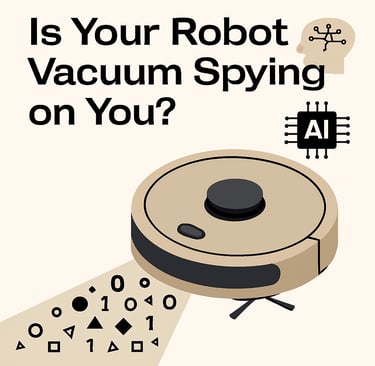Is Your Robot Vacuum Spying on You? How to Protect Your Privacy in the Age of Smart Homes
Smart devices have become part of everyday life, offering convenience and automation that once seemed futuristic. Yet behind this comfort lies a growing concern privacy. The robot vacuum, a staple of the modern home, may be doing more than just cleaning your floors. It could be mapping your home, tracking your daily routines, and collecting data that ends up far beyond your control. This post explores how these devices gather data, the risks involved, and the steps you can take to protect your digital privacy.
Thomas Gerritsen
10/6/20253 min read


Introduction
Smart devices have become part of everyday life, offering convenience and automation that once seemed futuristic. Yet behind this comfort lies a growing concern privacy. The robot vacuum, a staple of the modern home, may be doing more than just cleaning your floors. It could be mapping your home, tracking your daily routines, and collecting data that ends up far beyond your control. This post explores how these devices gather data, the risks involved, and the steps you can take to protect your digital privacy.
How Robot Vacuums Collect and Share Data
Modern robot vacuums are equipped with high-resolution cameras, microphones, and LiDAR sensors that help them navigate efficiently. While these features improve performance, they also allow the device to create detailed maps of your home. Every room layout, furniture position, and path the vacuum takes can become part of a stored digital profile.
Manufacturers often store this data in the cloud under the pretext of “AI improvement.” What many users do not realize is that once data leaves their home, it may be accessed by third-party partners or used for other commercial purposes. This process raises legitimate questions about consent and transparency in data handling.
What Happens When Your Data Leaves Your Home
When data collected by your smart devices is transmitted to external servers, you lose control. In one notable case, test images from Roomba units were leaked online, including a private photo of a woman using the toilet. These images were intended for AI training, yet they ended up in public forums.
Such incidents reveal the inherent risk of cloud-based storage and outsourcing data analysis to contractors. Once your data circulates beyond your direct ownership, it becomes vulnerable to misuse, resale, or exposure in data breaches. Your home, the most private place you have, should not double as a data source for global machinelearning systems.
Security Risks and Real Examples
Smart devices, including robot vacuums, are only as secure as their weakest link. Researchers have demonstrated how these devices can be exploited by hackers. Some were hijacked to livestream footage from inside homes, while others were manipulated to speak through built-in speakers or access sensitive information.
In one case, hackers gained remote control over a vacuum’s microphone, effectively turning it into a surveillance tool. These scenarios highlight that privacy breaches are not hypothetical they are technical realities that can affect families and businesses alike.
How to Protect Your Privacy
Protecting your privacy does not require giving up your smart devices. Instead, it means using them responsibly and understanding how to minimize risks. The first step is to choose models that support local data storage rather than cloud uploads. Devices that offer “Local Mode” or “offline operation” keep information on the device itself, reducing external exposure.
Next, review and limit app permissions. Many companion apps request unnecessary access to cameras, microphones, and locations. Disable these features when possible, and turn off options such as Cloud Sync or Remote Access if they are not essential.
Creating a separate Wi-Fi network for smart devices is another key defence. An isolated “IoT” network ensures that if one device is compromised, your main computer, banking information, and private files remain safe.
Finally, keep your devices updated. Regular firmware and app updates close known vulnerabilities. Combined with privacyconscious purchasing choosing brands that allow offline operation—these habits build a stronger layer of protection.
The Ethical Side of Smart Technology
Your robot vacuum is a small example of a much larger issue. Every connected device whether it’s a speaker, watch, or thermostat contributes to an ecosystem where convenience often outweighs consent. The line between useful automation and invasive surveillance is growing thin.
At The Cultured Code, we believe that technology should serve people, not exploit them. Our consultancy helps small businesses and families build privacy-first digital strategies, combining ethical audits, GDPR workflows, and hybrid cloud solutions that balance efficiency with integrity. We also deliver training workshops that help non-technical teams understand these concepts in plain English.
Final Thoughts
Technology is powerful, but it must remain accountable. When your vacuum can map your home and your phone can recognize your face, privacy is no longer optional it is fundamental. The goal is not to fear technology, but to use it wisely, with awareness and control.
If you want to learn how to secure your home or business from unnecessary data exposure, reach out to us at The Cultured Code. We help clients understand technology in a practical, ethical, and privacy-focused way.
Contact The Cultured Code
Schedule a discovery call or request a free digital review to assess your current setup.
Email: contact@theculturedcode.com
Website: theculturedcode.com
